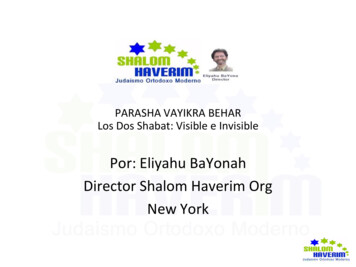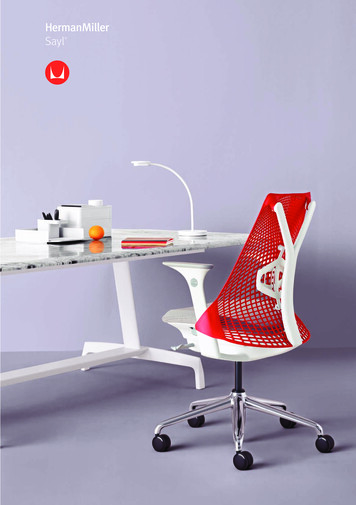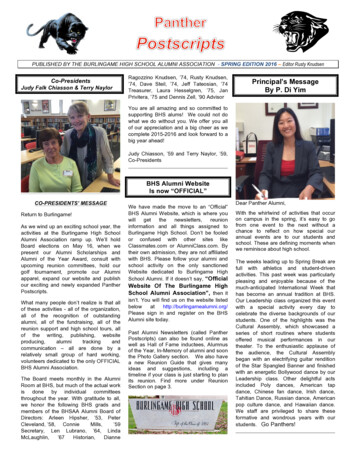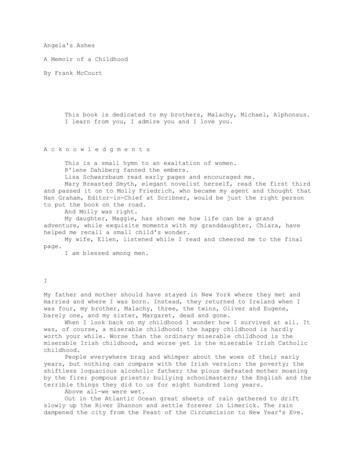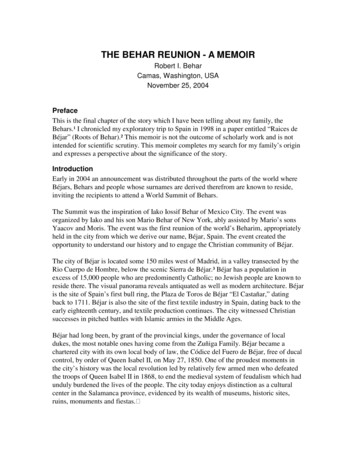
Transcription
THE BEHAR REUNION - A MEMOIRRobert I. BeharCamas, Washington, USANovember 25, 2004PrefaceThis is the final chapter of the story which I have been telling about my family, theBehars.¹ I chronicled my exploratory trip to Spain in 1998 in a paper entitled “Raices deBéjar” (Roots of Behar).² This memoir is not the outcome of scholarly work and is notintended for scientific scrutiny. This memoir completes my search for my family’s originand expresses a perspective about the significance of the story.IntroductionEarly in 2004 an announcement was distributed throughout the parts of the world whereBéjars, Behars and people whose surnames are derived therefrom are known to reside,inviting the recipients to attend a World Summit of Behars.The Summit was the inspiration of Iako Iossif Behar of Mexico City. The event wasorganized by Iako and his son Mario Behar of New York, ably assisted by Mario’s sonsYaacov and Moris. The event was the first reunion of the world’s Beharim, appropriatelyheld in the city from which we derive our name, Béjar, Spain. The event created theopportunity to understand our history and to engage the Christian community of Béjar.The city of Béjar is located some 150 miles west of Madrid, in a valley transected by theRio Cuerpo de Hombre, below the scenic Sierra de Béjar.³ Béjar has a population inexcess of 15,000 people who are predominently Catholic; no Jewish people are known toreside there. The visual panorama reveals antiquated as well as modern architecture. Béjaris the site of Spain’s first bull ring, the Plaza de Toros de Béjar “El Castañar,” datingback to 1711. Béjar is also the site of the first textile industry in Spain, dating back to theearly eighteenth century, and textile production continues. The city witnessed Christiansuccesses in pitched battles with Islamic armies in the Middle Ages.Béjar had long been, by grant of the provincial kings, under the governance of localdukes, the most notable ones having come from the Zuñiga Family. Béjar became achartered city with its own local body of law, the Códice del Fuero de Béjar, free of ducalcontrol, by order of Queen Isabel II, on May 27, 1850. One of the proudest moments inthe city’s history was the local revolution led by relatively few armed men who defeatedthe troops of Queen Isabel II in 1868, to end the medieval system of feudalism which hadunduly burdened the lives of the people. The city today enjoys distinction as a culturalcenter in the Salamanca province, evidenced by its wealth of museums, historic sites,ruins, monuments and fiestas.
Prior to 1492, Béjar was a small and remote provincial village. The peak Jewishpopulation at that time is estimated to have been twenty percent of the total population, agrouping of perhaps thirty to thirty-five families, with a likely population total of no morethan 300 persons. It is difficult to assess accurately how many Jews today who bear thename Béjar, Behar or one of their derivatives can be counted as direct descendants of theJewish residents of Béjar at the close of the fifteenth century.Many Christians throughout the world rightfully claim the surname Béjar, Behar orBejarano. They adopted the city’ s name for their surname as did the Jews.The Summit’ s attendees came from Canada, France, Bulgaria, Israel, South Africa, Spain,Mexico, Chile, and the United States of America. The Sephardic Béjar-derived surnamesrepresented at the Summit were Bachar, Bahar, Béjar, Behar, Bechar, Bejarano andBejerano. Other Sephardics who attended had the surnames Bendahan, Cohen, Melul,Misraji, Fernandez and Rodriguez. There are fifteen countries in which Jewish peoplewith Béjar or Behar-derived surnames reside and the attendees informed us that othersreside in at least six other countries.The SummitThe Summit was intended to be both joyful and informative. Those goals wereaccomplished. The experience for me, however, evolved into something personallyprofound.One additional and inspirational event which we experienced was the dedication andopening of the new and first Jewish cultural museum in Béjar. The details of theinspiration for the creation of the museum are related in the Afterword, including dueappreciation to David Melul of Barcelona, the benefactor.We had plenty of free time to toast our reunited “ cousins” and to trade anecdotal stories.We took the opportunity to wander about town, to sample the bookstores, shops andrestaurants and to take in the annual fiesta which was in progress. We also visited theareas in town in which the Jews had lived, touched the walls of structures which still bearthe evidence of the Jewish presence, grasped the soil in which our ancestors toiled andwere buried, and walked through historic ruins.We were very cordially provided with substantial information about the history of the cityand of the ancient Jewish presence there by the Manager of the Oficina de Turismo,including commemorative touring maps, books and a video of the city’ s history, all gratis.Sr. Alejandro T. Rubenstein of Mexico City, a professional genealogist, presented acomprehensive history of the names Béjar, Behar and the many surnames derived fromthem. We learned of the substantial impact that the Sephardic descendants with theBéjar- derived surnames have had in the world since the Expulsion in 1492.2
One evening, Ruth Behar showed her superbly produced video, “ Adio-Kerida,” amoving autobiographical TV documentary of her memories of her family’ s life in Cubaand her reflections on it.We were led on walking tours of Béjar, of the neighboring towns of Candelario andHervás, and of distant Toledo, all of which bore remnants of the ancient Jewish presence.Our guide was Marciano de Hervás, a historian of Béjar and Hervás, whose works arecited in the Bibliography.The foregoing descriptions of our intellectual experience are brief but should not be takento minimize the value of the information which we received about our origin. Theforegoing brevity is driven by the need to share the impacts of the information.The first evening’ s dinner banquet provided the Behars the opportunity to meet, hug,dance, tell tall stories, laugh and bond. Joyfulness ruled. The wonder of all of theseBeharim meeting each other, most never having met previously, was a grand experience.One fellow from San Diego, California met an aunt from Mexico whom he hadn’ t seen inthirty years and a cousin whom he had never met. Mere descriptions of that firstevening’ s encounter of Behars do not do justice to the moment.The evening was highlighted by the introduction of Iako Behar and Mario Behar, andthen the dignitaries and their spouses. David Melul cordially greeted us. The Director ofthe new museum delivered a synopsis of his book on the history of Béjar, and shared hispleasure for our reencuentro after our departure in 1492. Alcalde (Mayor) Alejo RiñonesRico spoke with words and in a tone which held the audience. He greeted us warmly andreflected that we are invested in the soil of Béjar, given that the bones of our ancestors liethere, and therefore, it is fitting that we now reunite with this land and its people. Thesentiment was simply stated and yet powerful. I was not as prepared as I should have beenand had not traveled to Béjar with the expectation of hearing such sensitivity.The next day we were invited to witness the inauguration of the museum, Museo JudíoDavid Melul de Béjar. We first, however, were requested to appear at the Ayuntamiento(City Hall). There, in full assembly in the chamber of the city council, the Alcalde greetedus formally and proclaimed, among other things, that we were torn from the breasts of theChristian townspeople, with whom we had lived in a peaceful co-existence, by the eventsof the fifteenth century (i.e., the Spanish Inquisition and subsequent Edict ofExpulsion ), that they are grateful for our return, terminating a long exile and that onceagain we should consider Béjar our home. We did not expect to hear such an eloquentstatement, but again, speaking for myself, I realized later that my pleasant surprise wasattributable to my inattention to the transformation which Spain has undergone.Photographers and television crews abounded. We exited and posed for groupphotographs. The story and pictures appeared in wide coverage the next day in the largestnewspaper serving the Salamanca province.3
We next strode to the new museum, witnessed the placement of the mezuzah at the doorand entered to view the first painted art and artifacts on exhibit.The interior’ s designis imaginative and will serve well to communicate powerful messages. The structure’ sretention of history in an attractive design merits its architect, Jose Luis RodríguezAntúnez, applause.We later attended a sumptuous luncheon generously hosted by David Melul for theattendees and by the City for the dignitaries invited by the City. An extensive awardsceremony followed, with the commendations awarded by David Melul personally and bythe City, acknowledging the contributions of the parties who organized and saw tofruition the Summit and the museum’ s creation.The family information of the attendees and of any other Beharim who wish to contributetheir information will be included in the website which has been established for theBeharim generations.Béjar HistoryThe observance of concise text prevents elaboration on the finite details of the Jewishpresence in Spain from biblical times to the Expulsion in 1492. The text in the sectionbelow titled “ Why” elaborates a bit further. The persons interested in delving further intothat colorful and at times sobering history will be well rewarded by turning to the workscited in the Bibliography.The origin of the name Béjar has been in constant scholarly dispute.I was gratified tolearn that the Spanish authorities have settled upon a belief which corroborates the theorywhich I offered in my earlier cited paper. The Alcalde presented each of us with theofficial pin of the city, emblematic of the origin of the name Béjar.The first known arrival of Jews into Béjar is reported to have occurred in the late twelfthcentury. We are told by the historian Sr. Avilés Amat that the Jews in Béjar enjoyed apeaceful co-existence with their Christian and Muslim neighbors until the establishmentof the Spanish Inquisition in 1480. A handful of Jews had voluntarily chosen to convert toChristianity from time to time. The townspeople, Christians, Jewish converts (conversos),observant Jews and Muslims alike, lived and worked according to commonly acceptedrules for civil co-existence. The town’ s adopted codes stated explicitly that all residents(i.e., without regard to religious beliefs) were to enjoy their rights equally. One indicationof the stability the Jews in Béjar felt was demonstrated by their willingness to volunteerto augment their tax assessments. Moreover, the Jewish community was known to makepersonal loans to local Christian dignitaries.The violence which erupted in 1391 in many areas of Spain, excepting Béjar, was in partstimulated by the increasing successes the Christian armies were having against theIslamic armies and by the increased zeal with which some fanatic Christian clericsworked to eliminate heresy as they understood the concept to mean. The more fearfulprovincial kings either permitted or failed to prevent violence to be visited upon their4
Jewish subjects, however valuable the Jews were to those kings. Sr. Avilés Amat,however, in researching the issue of violence in Béjar, consulted other authorities and wasunable to uncover any evidence of 1391 violence in Béjar, or any religious intolerancebetween the neighbors in Béjar prior to the Expulsion.The Jews in Béjar, as in most places in Spain, were granted the right to live in an aljama,which in Béjar was not a ghetto. According to the local historian Marciano de Hervás,several Jewish families felt free to reside in other areas of the town. The aljamas werelargely self-governing neighborhoods which were needed by the Jews for the purposesmore fully described below in this text. The only sanction which the King of Castilereserved to the crown regarding the aljama was the imposition of capital punishmentfollowing criminal convictions in the Jewish courts. The Jewish community in Béjar priorto the Expulsion had produced scholars, widely recognized rabbis, philosophers, authors,poets, physicians and civic leaders.Sr. Avilés Amat sadly reports that despite the good will which had existed in Béjarbetween the Christian and Jewish residents, once the Edict of Expulsion was promulgatedin 1492, the ravages of fanaticism reached Béjar in the form of bodily injuries and theft ofproperty. The thuggery on the eve of the Jews’ departure extended to the sacking ofstructures in the aljama. The thugs removed structural components for use in constructionelsewhere. Some aljama foundations remain, but most of the construction above thosefoundations with the exception of a few obscure habitations in narrow alleys and somedoorposts and lintels, is of post-fifteenth century vintage. The local historian, Marcianode Hervás, informs us in his La Juderia y Sinagoga de Béjar that in this same periodvandals sacked the synagogue, carrying away valuable fixtures and artifacts and thateventually the structure was left in ruins.Sr. Avilés Amat contritely reports that in the aftermath of the Expulsion, documentsdated after 1492 reveal that Catholic Kings donated to the local duke valuable goods leftbehind by the Jews in their haste to meet the Expulsion deadline, in order to compensatethe duke for the loss of rentals that the mandated departure had caused him to sustain. Sr.Avilés Amat compassionately concludes that no manner of compensation is possible forthe victims of such gross injustices.We are also told by Sr. Avilés Amat that the town of Béjar had enjoyed lasting benefitsfrom the cultural and economic contributions of the Jews. He further frankly reveals,somewhat ironically, that there is no denying that Jewish blood courses through the veinsof countless Christian Spaniards, including today’ s residents of Béjar. The telling of ourstory reveals many ironies, more of which I am obliged to share in this memoir.The FractureI refrain from recounting most of the morbid details of the excesses of the SpanishInquisition. Those events are revealed amply by the scholars whose works are listed in theappended Bibliography.5
We can briefly summarize that periodically organized intolerance and violence werevisited upon Jews for the only reason that the Jews insisted upon retaining their religion.The tenth and eleventh centuries were generally periods of achievement by the Jews,recognized for their efforts by both the Arab rulers and the Christian kings, a periodsometimes referred to by Sephardic Jews as their “ Golden Age” in Spain. Nevertheless,much of the difficulty which Jews experienced in the Middle Ages was instigated by theedicts of the Roman Catholic Church’ s Lateran Councils and the Papal Bulls, whichincreased the pressure upon the Jews to convert to Christianity.The widespread violence generated in 1391 caused the Jews in Spain in one era more lossof life and property than in any other comparable period. The status of the Jews thereaftercontinued to degrade, despite periods of relative calm. A great number of Jews convertedto Christianity out of fear. Some others converted but secretly continued in their Judaism.Those discovered to be secretly “ Judaising” were labeled marranos (swine) and often aspunishment were consigned to the flames in autos de fe, fiestas of acts of faith. ManyJews fled from Spain in this era.Animosity against the Jews in Spain was not normally shared by most Christianindividuals or kings. Fanatic clerics and their willing street thug accomplices, however,were often successful in turning townspeople and some kings against the Jews in times oframpant plagues, economic downturns and war. Any excuse could be used as a ruse forviolence. There were instances of some of the wealthier Jews flaunting finery or jewelryin public. That was not wise behavior in depressed economic times, but thecounterreactions could be excessive. Many kings hired Jews as bill collectors. Thereagain, the occupation could be fraught with danger in difficult economic times. Jewsneeded separate facilities in order to adhere to scriptural and Talmudic requirements forensuring kosher food production, the pursuance of secular and religious scholasticendeavor, the performance of religious ceremonies, the conduct of judicial proceedingsand the provision of ritual baths for the women. That activity, conducted apart from theChristian community, was often seized upon by fanatic clerics and lay miscreants asreason to accuse the Jews of sinister behavior and cause for summary illegal punishment.The height of the Inquisition eventually elicited entreaties from rulers in some Europeancountries to the Holy See in Rome to control the excesses. At one point the Popeconceded that matters had gone too far and wrote to the Church’ s hierarchy in Spain toremedy the situation. The admonition was not sent with the conviction or force requiredto cause much change.It must be stated that in its excess, the Inquisition was at times visited upon Christianswho were suspected of diverging from the Inquisition’ s expectations.6
WhyI have been asked more than once why I am so strongly motivated to maintain my identitywith the country which so mistreated my ancestors centuries ago. Most of the answer isburied in history. The remainder of the answer requires perspective.This is about justifying pride in the history of a culture without being prideful. The task ofvalidating the Jews’ case might seem daunting, but it strikes me as elemental that pridecan be the appropriate product of a culture if the record of accomplishments and thevalues of the culture warrant adulation. The risk is that use of platitudes alone without thesupporting evidence can turn the best intentioned expressions of praise into cliches. Thechallenge is to demonstrate that our Sephardicculture made its case for recognition ofits worthiness and for the right to remain vested in the lands of Spain.The Jewish presence in Spain by 1492 had exceeded 1800 years.The Jews precededChristianity and Islam. The Jews preceded the Romans, Carthaginians and Visigoths. TheJewish presence began in biblical times, as Jews wandered after release from captivity byBabylon in 538 b.c.e. Later, Jews traveled as emissaries to serve and augment observantJewish communities in what is now Morocco, and across the Straight of Gibraltar to otherJewish communities in Gades (now Cádiz, Spain) and elsewhere. In the aftermath of thedestruction of Israel by the Romans in 70 c.e., some of the scattered Jews made their waywest across North Africa to Spain.Life for the Jews in Spain was not without its trepidations. The Jews lived and workedamid a population consisting of remnants of the Celtic, Phoenician, Roman andCarthaginian cultures, with a predominance later of the fierce Visigoths who had movedin from north central Europe. It was the Visigoths who became the first significantconverts to Christianity in Spain. Once the formal conversion of the Visigothic Monarchyoccurred during the III Council in Toledo in 589, the Visigoths pursued their new religionand its evangelical goals with the zealousness that was characteristic of their historicferocity.The Islamic army led by Arab chieftans, with some participation by North Africantribesmen, invaded Spain in 711. The invading Islamic army was greeted by the Jews as aliberator from the harshness of their lives under the Visigoth kings. The Arabs, despitethe occasional discord with their Jewish residents in Arabia following the advent of Islamjust 80 years earlier, had historically viewed the Jews as people of the Book and had arespect for the mutual connection of Islam and Judaism to the patriarch, Abraham.The Jewish conditions improved markedly under Arab rule. How ironic it is that twice inJewish history, once in 711 and again in 1492, when Turkey openly welcomed the fleeingJews into the Islamic Ottomon empire, Islam came to the rescue, in view of the tragic andinsuperable strife which occurred between Israel and Islam in the twentieth century andcontinues to this day.7
The Jews over the centuries in Spain worked the land and introduced levels of superiorcraftsmanship in leathers, fabrics, gems and metals. They improved waste disposal andwater purity. They lived and at times died in armed defense of their kings. They obeyedthe scriptural commandment to remain loyal to their sovereign. They observed thecitizenship required of Christians, although the Jews were not always granted legalcitizenship status equal to that of the Christians. The Jews modernized commercialtransactions for their kings and demonstrated the lagging need to construct ships withwhich to compete commercially in the Mediterranean trade.Jews excelled in cartography and modernized maritime navigational charts. Their work,such as the products of the Cresques family, was used by Christopher Columbus in hisvoyages to the west. Jews, alongside Muslims, advanced agricultural techniques and thesciences, such as mathematics and astronomy. The Jews excelled in medical practice, theone service most appreciated by the Christian kings.The Jews unwittingly became part-financiers of the discovery of the New World bydelivering a fortune in gold to the monarchy of Isabella and Ferdinand in the waninghours of the Edict of Expulsion, as a plea for the revocation of the Edict. The plea wasrejected when the Grand Inquisitor entered the discussion and tossed thirty pieces ofsilver on the floor, to signify for the monarchs that if they nullified the Edict they wouldbetray Jesus Christ. The plea of the Jews was rejected but the gold pieces were retainedbecause the crown had been severely stressed financially by the costly effort to expelIslam. The money helped to complete the outfitting of the three ships which had beencommissioned to Columbus for his first voyage. The poignant story is often told byhistorians of how Columbus watched from his ship being prepared for sailing the nextday, as the fleeing Jews boarded other ships on the final day of the Expulsion deadline.Another one of our history’ s ironies.The duration of the Jews’ presence in Spain, their contributions to the country, theirloyalty and their endurance amid privation made their case for recognition of their vestingin the land, and that history is the underpinning of our pride. Our identity with ourancestors and the land, therefore, is not an affectation.We, the descendants, are an integral part of a continuum of our ancestors’ presence andvesting in Spain. Sephardic culture has always been sustained by our languages, bothCastillian Spanish and Ladino.The Sephardics’ continuation to speak Spanish, whenthey and their progeny could have forsaken Spanish in favor of the languages of thecountries which accepted them is one demonstration of the strength of their bond to theirhistory and to the lands of Spain. Our enjoyment of the foods which evolved from theculture; our repetition of the songs, poetry and anecdotal stories which illustrate the spirit,customs and hopes of our culture, are all elements of the continuum, undiminished by thepassage of time or by privation.Some scholars tend to scoff at use of cultural traditions for recounting history because ofthe threat of permeation of myth and fabrication. I maintain that combining myth and8
facts to comprehend generational life is a valuable means of telling the story. Holyscripture is a good example of the incorporation of myth in order to simplify the deliveryof important lessons. Cultural coloration, unless patently deceitful and sinister in purpose,is often the balm that gives life to events.Most of the of the older people in our generation feel the vibrancy of our continuum as itresonates in the depths of our being. It will not quell if we succeed in convincing thesucceeding generations of the need to nourish the continuum with study and reflectionand with the continuous celebration of our history, while observing the fundamentals ofJudaism, i.e., righteousness and good deeds.PerspectiveIt is difficult for the stranger to Sephardic history to grasp the depth of the sentimentswhich are held by Sephardim about the lands on which our ancestors toiled and died.I felt bedeviled by my initial readings about the Inquisition and Expulsion. My trip toSpain in 1998 did not yield the succor which I had sought because of my failure to seekanswers intelligently. I realize that anger stemming from meager knowledge and a lack ofperspective thwarted my search for the answer as to the Why.The catalyst which helped me to seek the light was the Behar Summit. The sensitiveremarks of Alcalde Riñones Rico, the anecdotal story of David Melul,the thoughts ofIako Behar and Mario Behar, the explanations by Sr. Rubenstein, the reflections of RuthBehar, and the candor of Sr. Avilés Amat all combined to cause me to re-examinereadings long forgotten and my approach for reconciling my emotions with reality.The progress of enlightenment is slow. The remarks which we heard in Béjar weremoving and reassuring. Much more, however, had preceded those remarks in thetwentieth century that demands that we fairly assess the meaning of the developments aswe shape our perspective.There has been a growing trend of outreach to Jewry by various authorities in Spain. Theremarks which we heard in Béjar are illustrative of the transformations which haveoccurred. The Spaniards have expressed themselves in their entreaties by use of the wordconviviencia, literally translated as living together, but in the larger sense used to say“ let’ s move on with better intentions.” The Spaniards use another word, reencuentro,translated as reunion, but in the larger sense used to mean a reuniting. These expressionsare not casually tossed around merely for effect by Spaniards. They are expressions whichare carefully measured to convey sincere intentions. These are the two words we heard inBéjar. The most powerful word used by Spaniards in the context of the reestablishment ofrelations with Jews is reconciliacion, meaning forgiveness. There have been deeds whichgive life to the use of such expressions: The Spanish Inquisition was terminated by the Spanish monarchy in 1834. Thisfollowed an earlier termination by the Napoleanic rule in Spain. Spain, upon9
ousting the French, punctuated the point that it could accomplish its own worthydeeds. During World War II, then Chief of State Generalisimo Francisco Franco saved11,535 Jews from the prospect of certain death at the hand of Nazi Germany bypermitting the Jews to enter Spain. Franco saved another 30,000 fleeing Jews in thesame period by granting them transit visas through Spain in order to enter Portugal.These courtesies were noteworthy events, given that Franco was viewed by somewestern governments as a ruthless dictator. Yet it was those same critics whichsummarily refused a boatload of fleeing European Jews any entry during the sameperiod. On December 16, 1968, the then Regent for the Monarchy, Francisco Franco andKing Juan Carlos I participated in the revocation of the Edict of Expulsion of 1492.That order revoking the Edict of the Expulsion was announced on that same dayin 1968 during the ceremonies held to dedicate the new Sephardic Synagogue inMadrid, attended by the Queen, Sofia,and by Catholic Archbishop CasimiroMorcillo of Madrid, the Spanish diplomatic corps and many international rabbis.Salamon Gaon, Chief Rabbi of the Spanish-Portuguese Synagogue in London,declared at the ceremony, “ the most brilliant history of our people was written inSpain.” In 1976, His Majesty King Juan Carlos I received a delegation of the World SefardiFederation to continue the work of the conviviencia. Prior to 1978 the Spanish Constitution explicitly stated that the Catholic Religion wasthe state religion of Spain. The new constitution of Spain ratified in May of 1978declared that there shall be no state religion.In a report published in 1990, it was revealed that the only Jew in the Cabinet, Sr.Enrique Mugica, had signed accords with Jewish and Protestant leaders to assure thatall persons in Spain were to enjoy all civil rights equally. The accord with Muslimswas to follow. In 1986, Spain recognized Israel and the two countries have since continued cordialdiplomatic relations. This was a momentous event for Israel and for world Jewry. On October 1, 1987, the King and Queen of Spain, accompanied by twenty-eight ofthe highest Spanish officials, visited the Sephardic Temple Tifereth Israel in LosAngeles, California. It is likely that this was the first time in 1000 years that a Spanishking had attended ceremonies in a synagogue. The Jewish congregation witnessed thedeclaration of friendship between the Spanish government and Sephardic Jewry, andRabbi Jacob Ott’ s expressions of reconciliation.10
The Temple’ s leadership and the King remarked that Spain has embraced Jewry andthat the time of the Sephardic Diaspora (i.e., scattering and exile) had ended.The King then delivered a warm and revealing recitation of the Jews’ contributions toSpain despite the adversity which the Jews experienced, admitting the unjustpersecutions and expulsions, and stating that Spain takes responsibility for all of thepositives and negatives of the past. The King concluded by stating that Spain is proudof its kinship with the Jewish community, which is, and always will be, a living partof Spain’ s history. Tears ran uncontrollably throughout the Congregation during theceremonies.The Temple leadership and the Spanish officials exchanged commendations. TheKing then awarded Rabbi Jacob Ott the rank of Knight Commander of the Order ofCivil Merit of Spain, an order founded by the King’ s grandfather, King Alf
The Summit was the inspiration of Iako Iossif Behar of Mexico City. The event was organized by Iako and his son Mario Behar of New York, ably assisted by Mario's sons Yaacov and Moris. The event was the first reunion of the world's Beharim, appropriately held in the city from which we derive our name, Béjar, Spain. The event created the


